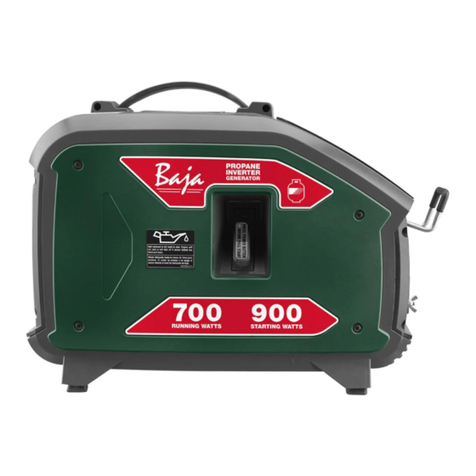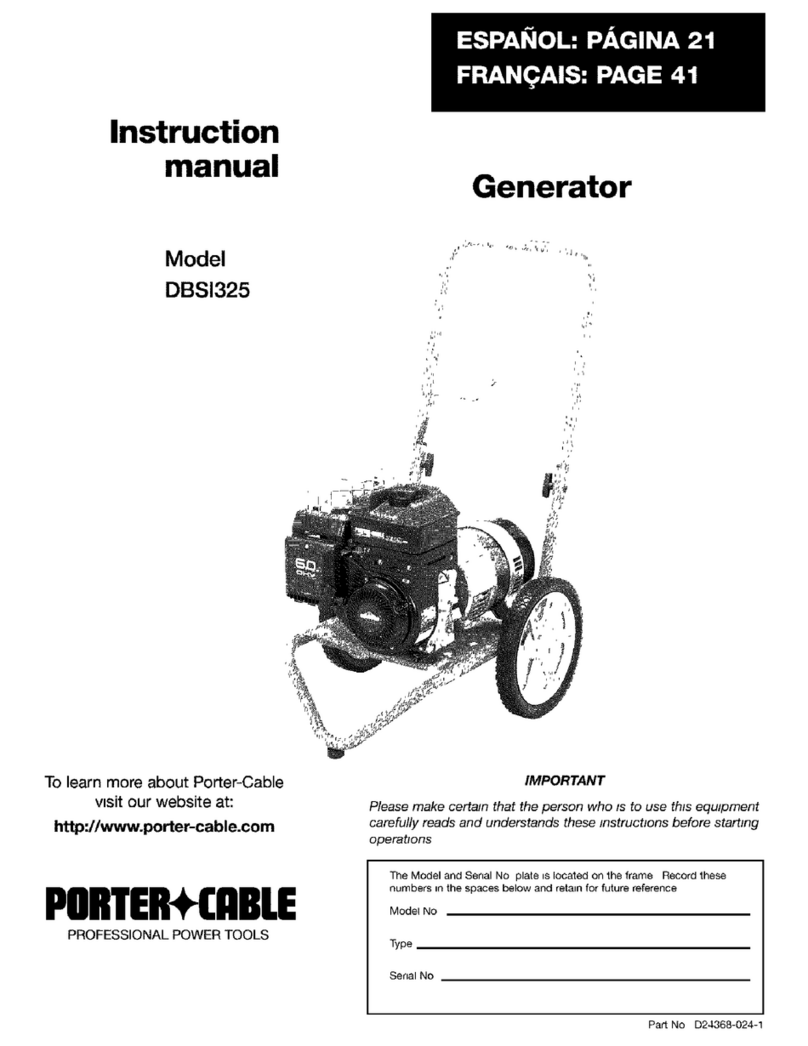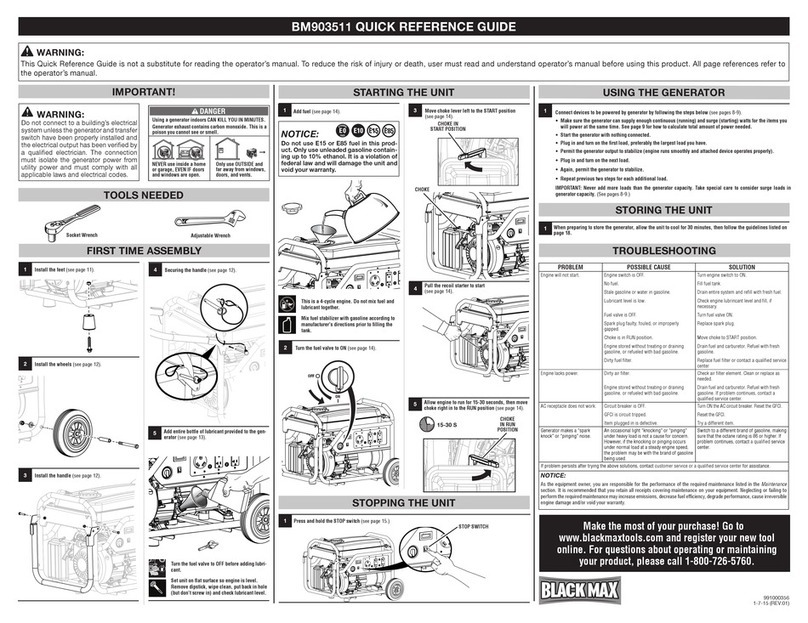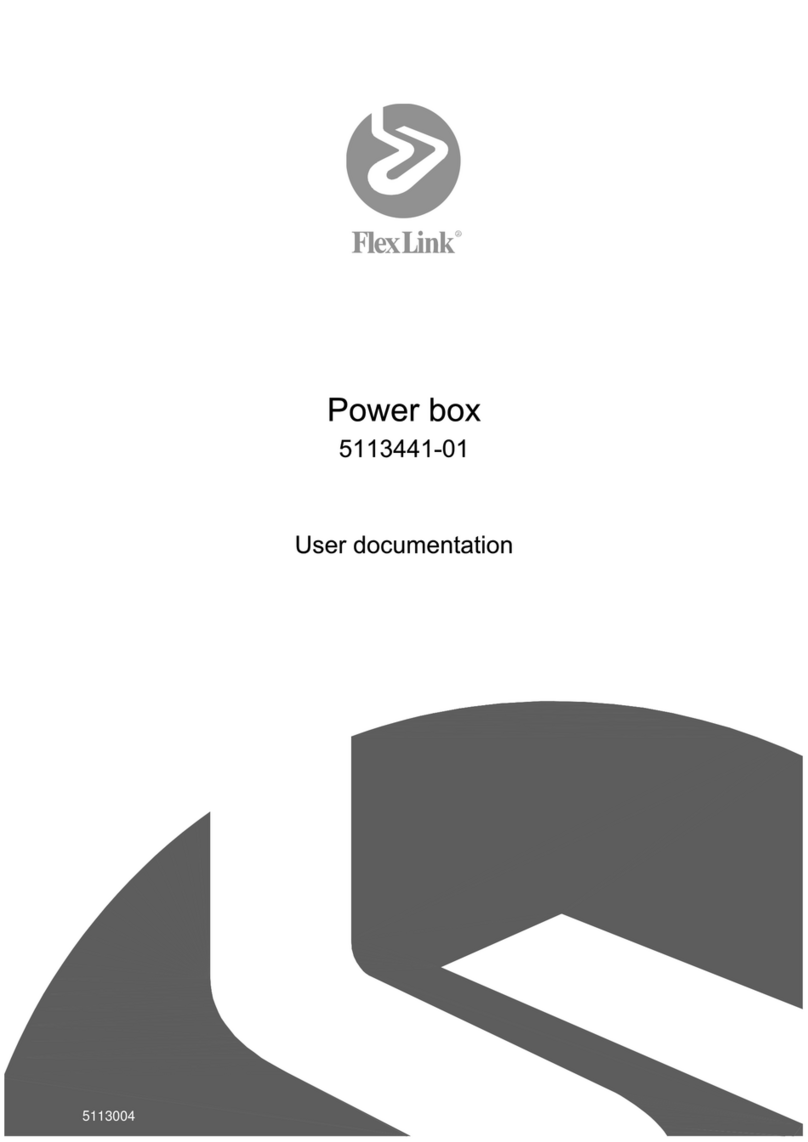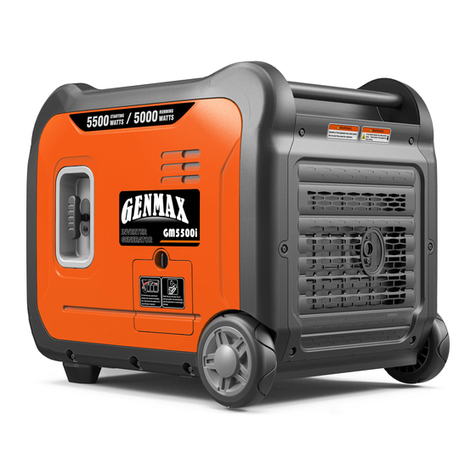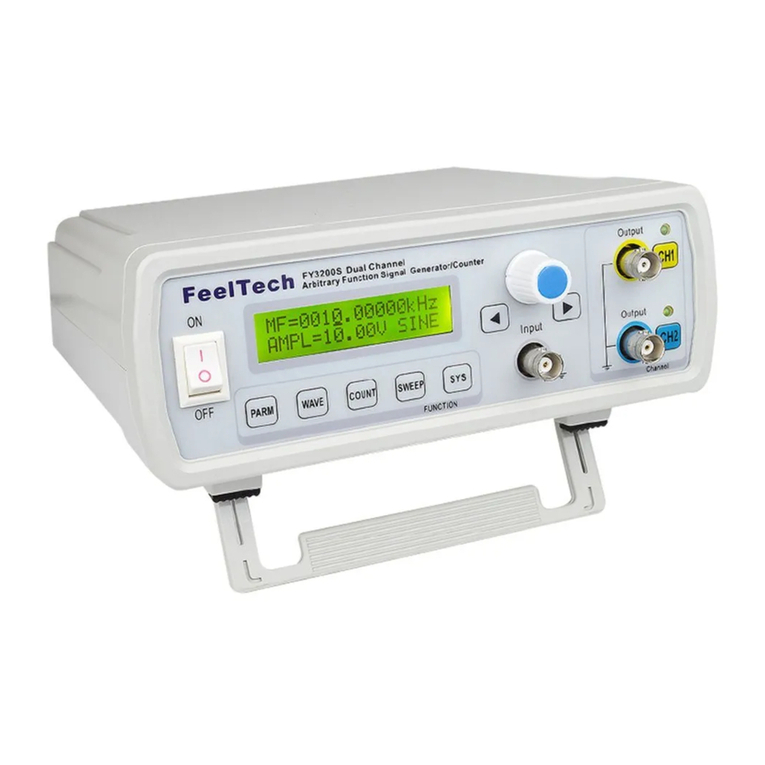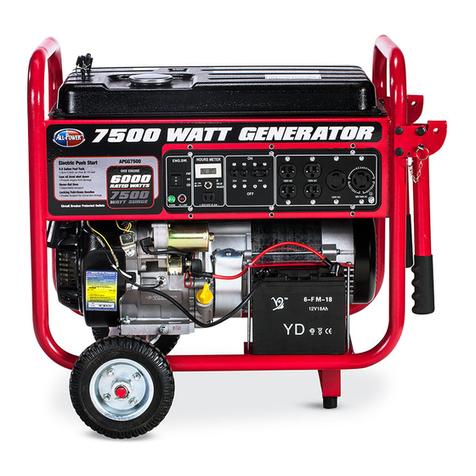PCC FTI FT-20 Operating instructions

49050-Revision M, Log #01212
FATIGUE TECHNOLOGY INC.
OPERATIONS, MAINTENANCE, AND REPAIR MANUAL
401 Andover Park East
Seattle, Washington 98188-7605 USA
(206) 246-2010
FT-20
Portable PowerPak
FTI Part #2720-015, Log #01212
Revision M
April 15, 2022
Original Instruction

Fatigue Technology Inc. 401 Andover Park East Seattle, WA • USA 98188-7605 Tel: (206)246-2010 Fax: (206)244-9886
49050-REV M
Fatigue Technology Inc. (FTI) is a world-leading aerospace engineering and manufacturing company. FTI
pioneered cold expansion technology (which provides solutions to fatigue problems associated with holes in metal
structures) back in 1969 and has advanced this science to develop innovative bushing and fastener products. These
proprietary products and associated tooling may be covered by patents or agreements owned by, or exclusively
licensed to Fatigue Technology Inc. Use of tooling procured from other than a licensed source may constitute
patent infringement.
The detailed tooling information in this manual was compiled and written by FTI. The tooling was designed
specifically for use with FTI’s Cold Expansion Systems. FTI cannot be held responsible for damage or injury as a
result of operating this equipment if it is used for other than the process intended, with any other tooling not
provided by FTI, or not used in accordance with the instructions contained in this manual. To avoid personal
injury, please observe all safety precautions and instructions. If you have any questions about the use or
serviceability of this equipment, please contact our Sales Department.
FTI’s Cold Expansion systems and processes are the subject matter of one or more of the following patents:
4,809,420; 4,885,829; 4,934,170; 5,083,363; 5,096,349; 5,103,548; 5,127,254; 5,129,253; 5,218,854; 5,245,743;
5,305,627; 5,341,559; 5,380,136; 5,405,228; 5,433,100; 5,468,104; 6,077,010; 6,183,180; 6,487,767; 6,792,657;
6,990,722; 7,024,908; 1,061,276; 513,898; 692015124; 581,385; 69310828; 468,598; 69105390; 643,231;
69414946; 696,686; 785,366; 1032769; and other patents pending. These systems and processes are tooling critical
and must be performed in accordance with FTI’s specifications or controlling documents. To ensure proper results
from FTI’s cold expansion systems and to be licensed to use FTI’s patented processes, it is essential that FTI’s
complete integrated system of tooling be purchased and utilized. The use of tooling purchased from other than a
licensed supplier could jeopardize fatigue life enhancement and may constitute patent infringement.
FTI reserves the right to change the specifications or configurations of tooling detailed in this manual as part of its
ongoing technical and product information program. Should inconsistencies occur between your tooling and this
manual, please contact our Sales Department.
ABOUT FATIGUE TECHNOLOGY INC.
Fatigue Technology Inc. (FTI) has provided innovative solutions to the aerospace industry since 1969. Our
products are used worldwide to reduce manufacturing and maintenance flow time and costs.
The FTI staff of professionals provides a full range of support services including:
•Application engineering
•Detailed project planning, implementation, and management
•On-site assistance, including training and tool room setup
The Sales Department is always available to assist with special fatigue enhancement requirements. Please contact
FTI with questions at any time.

Fatigue Technology Inc. 401 Andover Park East Seattle, WA • USA 98188-7605 Tel: (206)246-2010 Fax: (206)244-9886
49050-REV M
TABLE OF CONTENTS
SECTION DESCRIPTION PAGE
1.0 Introduction......................................................................................................................................... 1
1.1 About the FT-20 PowerPak ................................................................................................... 1
1.2 Identification of FT-20 Series PowerPaks ............................................................................. 1
1.3 General Specifications ........................................................................................................... 2
2.0 Safety .................................................................................................................................................. 3
3.0 FT-20 Operating Instructions.............................................................................................................. 5
3.1 Hydraulic PowerPak Setup Procedure and Operation ........................................................... 5
3.2 Actuation of PowerPak .......................................................................................................... 6
4.0 FT-20 Maintenance............................................................................................................................. 7
4.1 General Cleaning ................................................................................................................... 7
4.2 Checking Hydraulic Fluid Level............................................................................................ 7
4.3 Filling Hydraulic Fluid Reservoir.......................................................................................... 7
4.4 Changing the Hydraulic Fluid................................................................................................ 8
4.5 Lubrication and Air Requirements......................................................................................... 8
5.0 Troubleshooting .................................................................................................................................. 9
5.1 Pump Will Not Start or Stop.................................................................................................. 9
5.2 Mandrel Will Not Pull Back into the Barrel of the Puller Unit ........................................... 10
5.3 PowerPak Builds Hydraulic Pressure but Cannot Maintain Pressure.................................. 11
5.4 PowerPak Will Not Build Full Pressure .............................................................................. 12
5.5 Air Rushes Out around the Trigger...................................................................................... 12
5.6 Puller Retracts, But Will Not Return ................................................................................... 13
5.7 PowerPak Will Not Stop When Trigger is Released ........................................................... 13
6.0 FT-20A and FT-20-4K Illustrated Parts Breakdown ........................................................................ 14
6.1 External Fittings: FT-20A Side View; Parts List................................................................. 14
6.2 External Fittings: FT-20A Top View; Parts List ................................................................. 15
6.3 Basic Pump Assembly: FT-20A Front View; Parts List...................................................... 16
6.4 Basic Pump Assembly: FT-20A Top View; Parts List ........................................................ 17
7.0 FT-20 Illustrated Parts Breakdown................................................................................................... 18
7.1 External Fittings: FT-20 Side View; Parts List.................................................................... 18
7.2 External Fittings: FT-20 Top View; Parts List .................................................................... 19
7.3 Basic Pump Assembly: FT-20 Front View; Parts List......................................................... 20
7.4 Basic Pump Assembly: FT-20 Top View; Parts List........................................................... 21
8.0 Safety Data Sheet.............................................................................................................................. 22

Fatigue Technology Inc. 401 Andover Park East Seattle, WA • USA 98188-7605 Tel: (206)246-2010 Fax: (206)244-9886
49050-REV M
TABLE OF CONTENTS (CONTINUED)
SECTION DESCRIPTION PAGE
FIGURES
Figure 2.0-1 Safety Stickers .................................................................................................................................... 3
Figure 3.1-1 FT-20 PowerPak ................................................................................................................................. 5
Figure 5.6-1 Enerpac CT-604 Pressure Relief Tool .............................................................................................. 13
Figure 6.1-1 FT-20A External Fittings; Side View ............................................................................................... 14
Figure 6.2-1 FT-20A External Fittings; Top View................................................................................................ 15
Figure 6.3-1 FT-20A Basic Pump Assembly; Front View .................................................................................... 16
Figure 6.4-1 FT-20A Basic Pump Assembly; Top View ...................................................................................... 17
Figure 7.1-1 FT-20 External Fittings; Side View.................................................................................................. 18
Figure 7.2-1 FT-20 External Fittings; Top View................................................................................................... 19
Figure 7.3-1 FT-20 Basic Pump Assembly; Front View....................................................................................... 20
Figure 7.4-1 FT-20 Basic Pump Assembly; Top View ......................................................................................... 21

Fatigue Technology Inc. 401 Andover Park East Seattle, WA • USA 98188-7605 Tel: (206)246-2010 Fax: (206)244-9886
49050-REV M 1
SECTION 1.0: INTRODUCTION
This instruction manual contains information on the operation and maintenance of the FT-20 portable hydraulic
PowerPak. To obtain optimum performance and many years of trouble-free service, operate the PowerPak properly
and follow maintenance procedures carefully.
Read this manual before operating the PowerPak and retain it for future reference. If requested, FTI will provide
this manual in the language of the end-user.
1.1 ABOUT THE FT-20 POWERPAK
The FT-20 is a portable PowerPak that supports the FTI system of tooling. Because of its small size and light
weight, the FT-20 is particularly useful for work in areas with difficult or restricted access. It may be used to
operate FTI hydraulic puller units in the Little Brute and Medium Brute family. The FT-20 may also be used with
the Big Brute (BB-30) puller unit, though its operation will be slow when compared to the larger FT-200 PowerPak.
The FT-20 contains an air operated hydraulic pump that generates up to 10,000 pounds per square inch (psi)
hydraulic pressure (4,000 psi for the FT-20-4K). The air motor is driven by compressed air at 90 to 120 psi and
20 cubic feet per minute (cfm) flow through a 3/8-inch minimum inside diameter air hose. See Section 6.0 for
PowerPak configuration and schematics.
NOTE: The FT-20 is shipped with hydraulic fluid already in the unit. The FT-20 is shipped with a non-
vented cap on the reservoir. This must be replaced with the supplied vented cap and dipstick prior to
operation. If there is a need to fill the FT-20 with hydraulic fluid or drain the fluid for reshipment, please
refer to Section 4.3 for instructions.
1.2 IDENTIFICATION OF FT-20 SERIES POWERPAKS
There are three different models in the FT-20 series. The primary identification method is identified on the decal on
the side of the manifold.
•FT-20 is the original pump.
•FT-20A is an updated model. This is the most common model.
•FT-20-4K is a FT-20A with a reduced pressure setting of 4,000 psi.

Fatigue Technology Inc. 401 Andover Park East Seattle, WA • USA 98188-7605 Tel: (206)246-2010 Fax: (206)244-9886
249050-REV M
1.3 GENERAL SPECIFICATIONS
Dimensions: .........................................................In the box: 10” x 5.1” x 10.2”
Operational: 10” x 5” x 9.7”
Weight:.................................................................15.5 lbs. dry; 18.25 lbs. shipping weight
Operating Hydraulic Pressure: .............................10,000 psi maximum; 4,000 psi maximum for the FT-20-4K
Air Supply:...........................................................90 to 120 psi, clean and dry; 20 cfm flow minimum
Air Supply Hose:..................................................3/8” Inside Diameter
Air Lubricator Fluid:............................................5-20w synthetic oil
Hydraulic Fluid Capacity:....................................1/2 US gallons
Hydraulic Fluid Characteristics: ..........................Power Team Hydraulic Oil ASTM 215
Viscosity Index: ...........................................100 minimum
Viscosity: .....................................................48 SUS at 210°F, 215 SUS at 100°F
Specific Gravity at 60°F: .............................0.88
Flash Point, degrees: ....................................400°F
Fire Point, degrees: ......................................430°F
Pour Point, degrees: .....................................-30°F
Aniline Point, degrees:.................................210°F/220°F
Paraffinic Base Color:..................................ASTM 2.0
Suitable Substitutes for Hydraulic Fluid:.............Power Team hydraulic oil #9637; Enerpac Hydraulic Oil HF-100;
orUS MIL-SPEC #5606; or MIL-PRF-83282; or meets ISO 46; or
AeroShell 41; or ASTM 215; FTI Part Number 1045-154
Suitable Puller Units: ...........................................All Little Brute Puller Units, MB-30, MB-70, BB-30
Noise Reading......................................................85.2 to 89.8 dBA

Fatigue Technology Inc. 401 Andover Park East Seattle, WA • USA 98188-7605 Tel: (206)246-2010 Fax: (206)244-9886
49050-REV M 3
SECTION 2.0: SAFETY
Consult the appropriate puller unit manual for safety precautions before installing a puller unit onto a PowerPak.
When used in accordance with these instructions, the FT-20 is safe and easy to use. All general safety precautions
associated with hydraulic and pneumatically operated power tools should be observed. Many of these are noted in
this section. Ultimately, the operator is responsible for personal safety; however, the following general safety
precautions should be observed. Also see Figure 2.0-1.
CAUTION: Set the FT-20 PowerPak on a level surface. If the surface is out of plane, there is a risk of the
FT-20 PowerPak unit vibrating off the surface.
Read manual before using Always wear eye protection Always wear ear protection
Figure 2.0-1
Safety Stickers
1. Wear eye and ear protection when operating the FT-20.
2. Disconnect the air supply when:
•Maintenance is to be performed.
•Hydraulic hose is disconnected.
•PowerPak is not in use.
3. In the event of a ruptured or leaking hydraulic hose, IMMEDIATELY RELEASE THE TRIGGER AND
DISCONNECT THE AIR LINE from the PowerPak at the air input. Never use your hands to grasp a leaking
hose under pressure. The force of escaping hydraulic fluid can cause serious injury.
4. DO NOT attempt to disconnect the hydraulic hose while the pump is running.
5. DO NOT expose hoses to potential hazards, such as extreme heat or cold, sharp surfaces, heavy impact, or
vehicular traffic.
6. DO NOT allow hoses to kink, twist, curl, or bend so tightly that the oil flow within the hose is blocked or
reduced.
7. Periodically inspect the hose for wear or damage which could cause premature failure of the hose and possibly
result in injury.
8. Hose material and coupler seals must be compatible with the hydraulic fluid used.

Fatigue Technology Inc. 401 Andover Park East Seattle, WA • USA 98188-7605 Tel: (206)246-2010 Fax: (206)244-9886
449050-REV M
9. Hoses must not come in contact with toxic materials, such as creosote-impregnated objects and some paints.
Keep clean and never paint couplers or hoses. Hose deterioration due to chemical degradation may cause the
hose to fail under pressure.
10. DO NOT exceed the hydraulic pressure (psi) rating recommended or tamper with the internal high-pressure
relief valve. Creating pressure beyond rated capacities may result in personal injury and/or damage to the
PowerPak.
11. DO NOT exceed the recommended air pressure of 90 to 120 psi (6.2 to 8.3 bar).
12. Before operating the pump, tighten all hose connections using the proper tools. Do not overtighten the
connections. Connections need only be tightened securely and leak-free. Overtightening may cause premature
thread failure, or high-pressure fittings to split at pressures lower than their rated capacities.
13. Periodically pump clean oil through the entire length of the hose, then pressurize the hose and check for leaks
at the crimped connectors, between the hose material and the fitting, and between the fitting and coupler.
14. Before replenishing the oil level, retract all cylinders to prevent overfilling the pump reservoir. Overfilling
may cause personal injury due to excess reservoir pressure created when the cylinders are retracted.
15. Do not use the hose to move attached equipment. Stress may damage the hose and cause personal injury.
16. DO NOT use in potentially explosive atmospheres.
IMPORTANT: FTI completed a risk assessment on this unit at our factory. Any modifications done by a third
party or the final user are excluded from that risk assessment. As a result, modifications done by a third party or the
final user nullify the CE marking.

Fatigue Technology Inc. 401 Andover Park East Seattle, WA • USA 98188-7605 Tel: (206)246-2010 Fax: (206)244-9886
49050-REV M 5
SECTION 3.0: FT-20 OPERATING INSTRUCTIONS
Become familiar with these instructions before operating the FT-20.
3.1 HYDRAULIC POWERPAK SETUP PROCEDURE AND OPERATION
See Section 6.0 for parts identification.
Conduct the following procedures BEFORE actuation:
1. Remove the pipe plug and attach the main air hose quick disconnect to the air inlet fitting. The air supply must
be clean and dry, and 90 to 120 psi at a minimum flow of 20 cfm.
NOTE: Clean the top plate of the pump before removing the filler cap and dipstick to prevent
contaminants from entering the oil supply.
2. Remove the shipping plug from the reservoir fill port and replace with the supplied vented cap.
3. The fill line on the reservoir is 5/16 inch from the top.Visually inspect the oil level in the reservoir. When
operating, make sure the reservoir vented cap is in place. The oil level should be within 5/16 inch of the filler
plug; if the pump is to be operated with the reservoir unvented, the oil level should be 3/4 inch from the filler
plug. If the oil level is low, replenish the hydraulic fluid per the instructions in Section 4.3.
4. Inspect all threads and fittings for signs of wear or damage and replace them if necessary.
5. Uncoil the hose assembly from the puller unit to be used and inspect all threads, couplings, and hoses for
damage and degradation. Replace if necessary.
6. Remove the dust caps from the
hydraulic fittings of the FT-20 and
puller unit hose, and clean both couplers
prior to connecting to prevent
contaminants from entering the oil
supply. Thread the hydraulic hose
coupler from the puller unit to the quick
hydraulic coupler of the PowerPak.
NOTE: Ensure that the couplers on
both the PowerPak and hose fittings
are pushed firmly together, then
completely screwed together. Failure
to do so will prevent the oil from
returning to the pump when the
trigger is released. This will cause
the puller unit to stay in the retracted
position.
7. Clean, then connect the two air quick
disconnects from the puller unit to the
coupler plug and coupler socket of the
PowerPak.
Main Air
Supply Quick Connect
Air Quick
Couplers
Pump Quick
Hydraulic Coupler
Trigger
Response Valve
Figure 3.1-1
FT-20 PowerPak

Fatigue Technology Inc. 401 Andover Park East Seattle, WA • USA 98188-7605 Tel: (206)246-2010 Fax: (206)244-9886
649050-REV M
CAUTION
It is suggested that an automatic air line oiler/filter be installed as close to the pump as possible. Set oiler to
feed 1 to 3 drops per minute into the system. Use No. 10 SAE non-detergent oil. NOTE: An oiler package
(including gage, filter, lubricator, and fittings) is NOT included with the FT-20 but is available from FTI.
Please contact our Sales Department for details.
3.2 ACTUATION OF POWERPAK
CAUTION: Set the FT-20 PowerPak on a level surface. If the surface is out of plane, there is a risk of the
FT-20 PowerPak unit vibrating off the surface.
1. The PowerPak is an air-driven hydraulic unit and can be activated only when connected to a FTI puller unit or
remote trigger as described in Section 3.1.
2. Activate the FT-20 by depressing the trigger on the handle of the puller unit. An air logic valve opens, allowing
the main air supply into the air motor which drives the hydraulic pump. Hydraulic pressure is transmitted
through the hose to the cylinder of the puller unit, which then retracts the hydraulic piston.
3. Releasing the trigger allows the air logic valve to shift and air pressure in the puller unit barrel returns the puller
piston to the start position.
4. If actuation fails to take place, the trigger response valve may need to be adjusted. This is done by loosening
the brass nut on the trigger response valve. Connect the pump main air supply and the puller unit. Then, with
the puller unit trigger depressed, adjust the pilot screw in (clockwise) or out (counterclockwise). Turning the
pilot screw in makes the trigger more sensitive, while adjusting it out makes it less sensitive. Once the desired
sensitivity is achieved, retighten the brass nut. Different puller units may require this valve to be readjusted.

Fatigue Technology Inc. 401 Andover Park East Seattle, WA • USA 98188-7605 Tel: (206)246-2010 Fax: (206)244-9886
49050-REV M 7
SECTION 4.0: FT-20 MAINTENANCE
The FT-20 requires routine checking of the unit and periodic preventative maintenance to ensure safe, trouble-free
operation. No special maintenance is required. The following actions are suggested.
CAUTION:
Disconnect the PowerPak from air supply before performing maintenance or repair.
4.1 GENERAL CLEANING
1. Periodically clean the outer surfaces of the FT-20 and equipment used with the FT-20.
2. When not in use, ensure that the dust cap is reinstalled on the hydraulic coupler.
3. Keep all hose connections free of metal chips, dirt, and grime.
4. Keep the breather hole in the vented filler cap and dipstick clean and unobstructed.
5. The hydraulic oil should be replaced every 200 to 500 hours of use, depending on severity of use and
environmental conditions.
6. Always clean the hydraulic and air couplers prior to making connections.
4.2 CHECKING HYDRAULIC FLUID LEVEL
1. Clean the top plate, remove the filler cap and dipstick, and visually check the oil level in the reservoir after
every 40 hours of use.
2. The proper oil level is within 5/16 inch of the top of the reservoir when the puller unit’s mandrel is in its normal
starting position (mandrel extended and trigger released). The fill line on the reservoir is 5/16 inch from the
top.
4.3 FILLING HYDRAULIC FLUID RESERVOIR
1. Disconnect the puller unit from the PowerPak and the air supply when adding oil to the reservoir.
2. Clean the entire area around the vented filler cap and dipstick before removing the filler plug located to the right
and slightly behind the hydraulic quick coupler.
3. Remove the filler cap and dipstick. Insert a clean funnel with a flexible tube and strain the new oil through a
paper filter. If a flexible tube is not available, the pump shroud may need to be removed for access.
4. Fill with hydraulic fluid to within 5/16 inch of the top of the filler hole. The fill line on the reservoir is 5/16
inch from the top. See Section 1.3 for hydraulic fluid specifications.
5. Replace the filler cap and dipstick and make sure the breather hole in the filler cap and dipstick is open. Cycle
the PowerPak (with the puller unit attached) several times, and recheck the oil level in the PowerPak reservoir.

Fatigue Technology Inc. 401 Andover Park East Seattle, WA • USA 98188-7605 Tel: (206)246-2010 Fax: (206)244-9886
849050-REV M
4.4 CHANGING THE HYDRAULIC FLUID
1. After approximately 200 to 500 hours of use, the hydraulic fluid should be changed. The frequency of oil
changes will depend upon the general working conditions, severity of use, overall cleanliness, and care given
the PowerPak.
2. To drain the FT-20, remove the shroud and cover retainer screws and expose the reservoir. (If a drain plug is
present, unscrew the plug and drain the oil through the port.)
3. Drain the hydraulic fluid by pouring the oil over and out one corner of the reservoir.
4. Refill the reservoir with hydraulic fluid. See Section 1.3 for hydraulic fluid specifications.
5. Replace the pump on the reservoir, torquing the cover plate retaining screws to 25/30 in-lbs. Make sure the
reservoir gasket is in place.
6. Replace the shroud.
4.5 LUBRICATION AND AIR REQUIREMENTS
1. The air supply must be clean and dry, and provided at 90 to 120 psi. Volume must be a minimum of 20 cfm,
and a 3/8-inch inside diameter air hose is recommended.
2. FTI recommends that an automatic air line filter/oiler be installed in the air inlet line as close to the PowerPak
as possible. Set the oiler to feed 1 to 3 drops of oil per minute (one drop for every 50 to 75 cfm of air) into the
system. Use SAE No. 10 non-detergent oil.

Fatigue Technology Inc. 401 Andover Park East Seattle, WA • USA 98188-7605 Tel: (206)246-2010 Fax: (206)244-9886
49050-REV M 9
SECTION 5.0: TROUBLESHOOTING
This section provides some basic steps to identify possible causes of trouble, together with troubleshooting
solutions. The FT-20 is a sealed unit. If there are any problems with the PowerPak which go beyond the scope of
these instructions, contact Fatigue Technology Inc. or an FTI Representative who can provide you with the nearest
authorized service center.
WARNING:
To prevent injuries, any repair work or troubleshooting must be done by qualified personnel familiar with
this equipment. Use proper equipment and tools when troubleshooting.
IMPORTANT: Refer to the parts lists (Section 6.0) when using the Troubleshooting Guide.
PROBLEM
CAUSE
SOLUTION
5.1 PUMP WILL NOT START OR WILL NOT STOP REGARDLESS OF TRIGGER POSITION
NOTE: This is common for new pumps or different puller unit/pump combinations.
(a) Trigger response valve is not
properly adjusted.
(a) While squeezing the trigger of the puller unit,
loosen the brass nut on the trigger response
valve. Adjust the valve pilot in or out until the
desired sensitivity is obtained. Retighten the
brass nut.
(b) Air logic valve is stuck in
position.
(b) The air logic valve is located on top of the pump
just under the shroud. Remove the shroud and
disassemble the valve. Remove the valve spool
and inspect the O-rings and spool body. If the
valve is a Versabrand valve (gold body),
replace the O-rings as required and remove any
contaminates. If the valve is an I.S.I. brand valve
(black body), the spool will most likely need to
be replaced. Clean any contaminates from the
valve body. Refer to Section 6.0 for valve part
numbers.

Fatigue Technology Inc. 401 Andover Park East Seattle, WA • USA 98188-7605 Tel: (206)246-2010 Fax: (206)244-9886
10 49050-REV M
PROBLEM
CAUSE
SOLUTION
5.2 MANDREL WILL NOT PULL BACK INTO THE BARREL OF THE PULLER UNIT
(a) Inadequate air pressure or
flow.
(a) Obtain air pressure at 90 to 120 psi and flow at
20 cfm with a hose diameter of 3/8-inch
minimum inside diameter.
(b) Trigger response valve is not
properly adjusted.
(b) While squeezing the trigger of puller unit, loosen
the brass nut on the trigger response valve.
Adjust the valve pilot in or out until the desired
sensitivity is obtained. Retighten the brass nut.
(c) Loose oil coupling to the
puller unit.
(c) Check the quick-disconnect couplings on the
hose and pump. Inspect couplers to ensure that
they are completely tightened.
(d) Oil level too low. (d) Refer to Section 4.2, Checking Hydraulic Fluid
Level.
(e) Hydraulic line from the puller
unit is not attached to the
hydraulic quick-coupler.
(e) Connect the hydraulic line to the hydraulic quick-
coupler.
(f) Vacuum in reservoir. (f) Check for a plugged vent in the vented filler cap
and dipstick. Loosen the filler cap 1 to 2 turns.
(g) Flow check valve in coupler
does not stay open when
coupler is connected properly.
(g) Replace the coupler.
(h) Dirt in pump or filter plugged. (h) The oil pick-up strainer should be cleaned; if
necessary, the PowerPak should be dismantled
and all parts inspected and cleaned. Replace the
hydraulic oil.
(i) Leak in the air circuit. (i) Ensure there are no air leaks from any fittings.
Tighten fittings to eliminate the leaks. NOTE:
Leaks from the puller unit trigger are acceptable.
(j) Relief valve or low pressure
unloading valve is out of
adjustment.
(j) Readjust as needed. Because this adjustment is
complex, contact FTI about procedures for return
or repair.

Fatigue Technology Inc. 401 Andover Park East Seattle, WA • USA 98188-7605 Tel: (206)246-2010 Fax: (206)244-9886
49050-REV M 11
PROBLEM
CAUSE
SOLUTION
5.3 POWERPAK BUILDS HYDRAULIC PRESSURE BUT CANNOT MAINTAIN PRESSURE
CAUTION:
Operation of the pump motor with it lifted from the reservoir (Step 5.3c) may result in oil spray.
Please shroud the assembly accordingly.
(a) Insufficient volume of air. (a) Check the air supply. Hoses should be 3/8-inch
inside diameter.
(b) External oil leaks. (b) Replace leaking pipe fittings. Reseal or replace
any faulty line fittings. If no oil leakage is
visible, the problem may be internal.
(c) Pressure control valve leaks. (c) To test for a leaking control valve lift the pump
from the reservoir but keep the intake filter in the
oil. Remove the drain line to see if the oil is
leaking from the valve. If the control valve is not
leaking, the internal check valve could be
leaking.
(d) Piston packing or valve seats
are damaged.
(d) Return the pump to FTI for repair.

Fatigue Technology Inc. 401 Andover Park East Seattle, WA • USA 98188-7605 Tel: (206)246-2010 Fax: (206)244-9886
12 49050-REV M
PROBLEM
CAUSE
SOLUTION
5.4 POWERPAK WILL NOT BUILD FULL HYDRAULIC PRESSURE
(a) Inadequate air pressure or air
flow.
(a) Increase air pressure and/or hose diameter.
(b)
Faulty pressure gage.
(b)
Calibrate the gage.
(c)
External fitting leakage.
(c)
Replace the leaking pipe fitting.
(d) Faulty internal pressure
regulator.
(d) Lift the pump from the reservoir but keep the
filter immersed in oil. Note the pressure reading
when the relief valve begins to open. If it is
functioning normally, the pressure should start
to bleed off at 9,500 to 10,000 psi (4,000 psi for
the FT-20-4K).
(e) Internal leakage in puller unit. (e) Disconnect the puller unit. Use a different
puller unit to test the PowerPak; if it builds to
full pressure using a different puller unit, the
first puller unit is defective. If another puller
unit is unavailable, look for oil leaks and their
locations. Refer to the appropriate puller unit
manual for instructions.
(f)
Leaks in the pressure valve.
(f)
Clean and reseal or replace the valve.
(g) Piston packing or valve seats
are damaged.
(g) Return the pump to FTI for repair.
5.5 AIR RUSHES OUT AROUND THE TRIGGER OF THE PULLER UNIT WHEN ACTUATED AND
PUMP DOES NOT OPERATE.
NOTE: Minor air leakage from the trigger is normal.
(a) An air line from the puller unit
is not connected.
(a) Connect the air line.
(b) The trigger response valve is
not properly adjusted.
(b) While squeezing the trigger of the puller unit,
loosen the brass nut on the trigger response
valve. Adjust the valve pilot in or out until the
desired sensitivity is obtained. Retighten the
brass nut.
(c) Hose fittings from the puller
unit or PowerPak are reversed.
(c) Check all hose fitting configurations in the
puller unit manual.
(d) Air logic control valve is stuck
in position.
(d) Refer to 5.1 (b).
PROBLEM
CAUSE
SOLUTION

Fatigue Technology Inc. 401 Andover Park East Seattle, WA • USA 98188-7605 Tel: (206)246-2010 Fax: (206)244-9886
49050-REV M 13
5.6 PULLER RETRACTS ON FIRST TRIGGER ACTUATION, BUT WILL NOT RETURN TO
START POSITION.
(a) The new puller unit requires
lubrication through the piston
and cylinder.
(a) Cycle the trigger several times to introduce
hydraulic fluid to the cylinder. If piston fails to
return, proceed to 5.6 (b).
(b) The hydraulic quick coupler
has not been completely
tightened at the PowerPak
manifold. This allows the
check valve in the puller
unit’s hydraulic quick coupler
to close on the return stroke.
(b)
1) Disconnect the air supply from the FT-20.
2) Disconnect the coupler from the FT-20.
3) Connect Enerpac CT-604 to the coupler
and bleed off hydraulic oil to relieve the
build-up. Figure 5.6-1 shows the Enerpac
CT-604 Pressure Relief Tool.
4) Once pressure is relieved, the coupler may
be tightened and reinstalled onto the
PowerPak.
5) Reattach the air lines to get the puller unit
to return.
6) Check the oil level in the PowerPak
reservoir.
5.7 POWERPAK WILL NOT STOP OPERATING WHEN TRIGGER IS RELEASED.
(a) Puller unit retracts and will
not return because hydraulic
pump will not shut off, or
there is a delay in PowerPak
shutoff.
(a) Trigger response valve is not properly adjusted.
See 5.1 (a).
(b) Air logic control valve is
stuck in position.
(b) See 5.1 (b).
Figure 5.6-1
Enerpac CT-604 Pressure Relief Tool

Fatigue Technology Inc. 401 Andover Park East Seattle, WA • USA 98188-7605 Tel: (206)246-2010 Fax: (206)244-9886
14 49050-REV M
SECTION 6.0: FT-20A AND FT-20-4K ILLUSTRATED PARTS BREAKDOWN
Note: There are three configurations of the FT-20 PowerPak: the original FT-20, the revised FT-20A, and the
reduced pressure FT-20-4K. The style of pump is identified on Decal #2 in the figure below. Section 6.0
describes the FT-20A, while Section 7.0 describes the original FT-20. Use the FT-20A section for the
FT-20-4K.
6.1 EXTERNAL FITTINGS: FT-20A, SIDE VIEW; PARTS LIST
Item
Number
FTI
Part Number
SPX
Part Number
Applicable
Model No.
Number
Required
Description
1
1125-003
14726 or 15883
FT-20A
0.4 foot
Tubing
2
-----
FT-20A
1
Decal
3
1047-013
FT-20A
1 Hydraulic Quick Coupler
1047-090
FT-20-4K
4
1125-005
61243
FT-20A
1
Plastic Reservoir
5
1125-007
33853
FT-20A
1
Reservoir Gasket
6
1125-003
14726 or 15883
FT-20A
0.5 foot
Air Hose
7
1125-002
15457
FT-20A
4
90-Degree Elbow Fitting
8
1125-036
53092GY8
FT-20A
1
Shroud
--
1187-770
FT-20A
0
Pressure Relief Tool1
Note 1: Not included.
Figure 6.1-1
FT-20A External Fittings; Side View
1
8
7
6
5
3
2
4

Fatigue Technology Inc. 401 Andover Park East Seattle, WA • USA 98188-7605 Tel: (206)246-2010 Fax: (206)244-9886
49050-REV M 15
FT-20A
6.2 EXTERNAL FITTINGS: FT-20A, TOP VIEW; PARTS LIST
Item
Number
FTI
Part Number
SPX
Part Number
Number
Required
Description
1
1125-010
250026
1
1/4-Inch Straight Nipple Fitting
2
1125-012
208699
1
1/4-Inch Tee Fitting
3
1125-039
15426
1
1/4-Inch Straight Nipple Fitting
4
1125-021
250024
1
Quick Coupler (Air Outlet to Puller Unit)
5
1125-013
208218
1
1/8-Inch Straight Fitting
6
1125-014
19463
1
1/8-Inch Tee Fitting
7
1125-020
213343
1
Quick Plug Coupler (Air Inlet from Puller Unit)
8
1125-022
213346
1
Speed Control Muffler (Trigger Response Valve)
9
1125-016
14680
1
90-Degree Elbow Fitting
10
1125-040
10807
3
Hex Socket Head Cap Screw
11
1125-018
211060
6
Plastic Screw (Torque to 25/30 in-lbs)
12
1125-041
351086
1
4-Way Air Valve
13
1125-042
351096-BK2
1
Valve Mounting Plate
14
1125-019
250025
1
Quick Coupler (Main Air Intake)
Figure 6.2-1
FT-20A External Fittings; Top View
8
11
10
13
14
1
2
3
4
7
6
5
9
12
13

Fatigue Technology Inc. 401 Andover Park East Seattle, WA • USA 98188-7605 Tel: (206)246-2010 Fax: (206)244-9886
16 49050-REV M
FT-20A
6.3 BASIC PUMP ASSEMBLY: FT-20A, FRONT VIEW; PARTS LIST
Item
Number
FTI
Part Number
SPX
Part Number
Number
Required
Description
1 1125-024 209375 1
Cap and Gasket Assembly (red plug and black
operations plug without dipstick [units prior to
compliance with European Union Machinery
Directive 2006/42/EC])
1 1125-064 1
Aluminum cap with dipstick (units compliant with
European Union Machinery Directive 2006/42/EC)
2
1125-043
64767
1
Pump Body
3
1125-025
17428
4
Cos. Head Cap Screw (Torque to 85/95 in-lbs)
Figure 6.3-1
FT-20A Basic Pump Assembly; Front View
Table of contents
Popular Portable Generator manuals by other brands

Champion
Champion 100423 Operator's manual
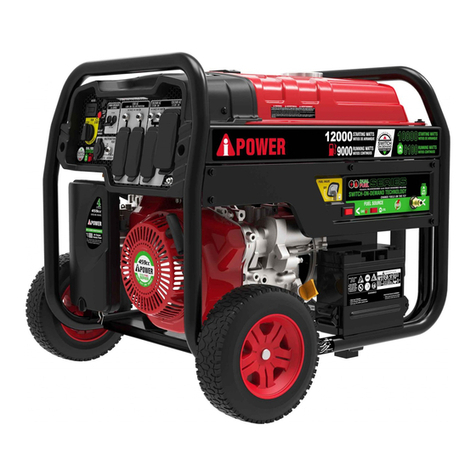
iPower
iPower SUA12000ED owner's manual
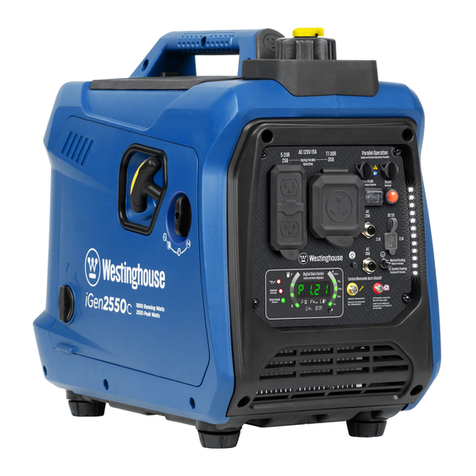
Westinghouse
Westinghouse iGen2550c quick start guide
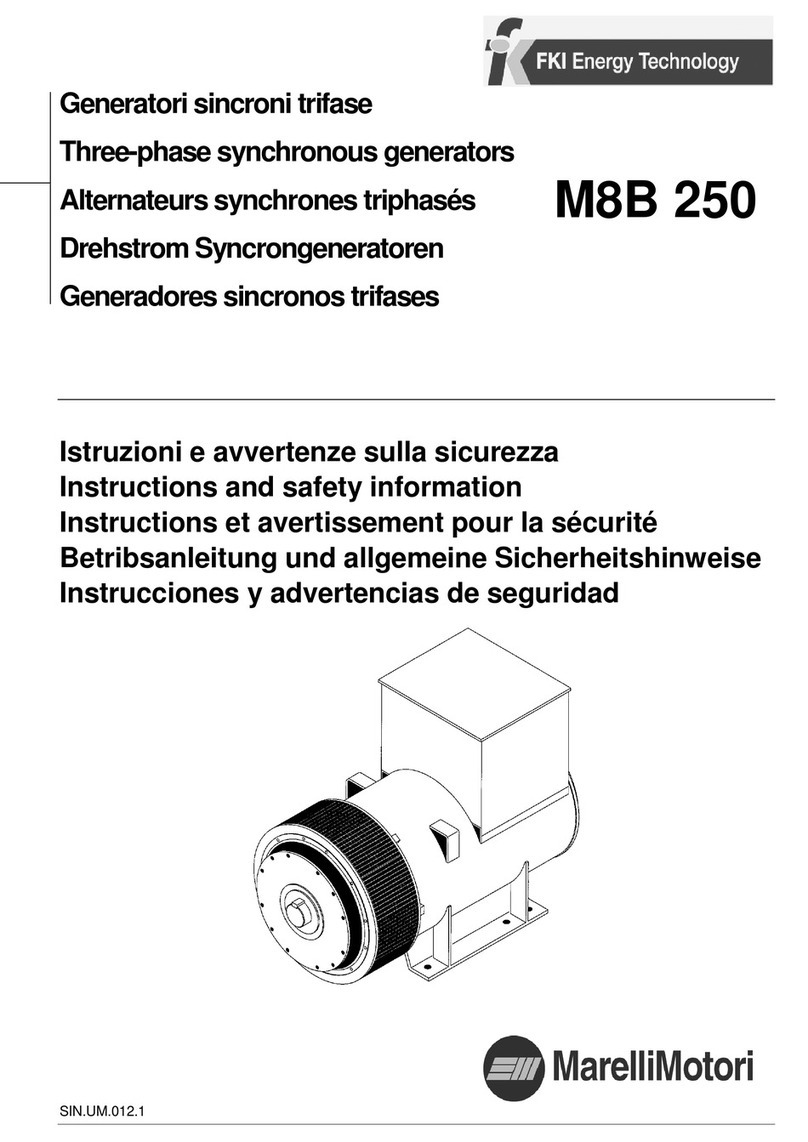
MarelliMotori
MarelliMotori M8B 250 Instructions and Safety Information
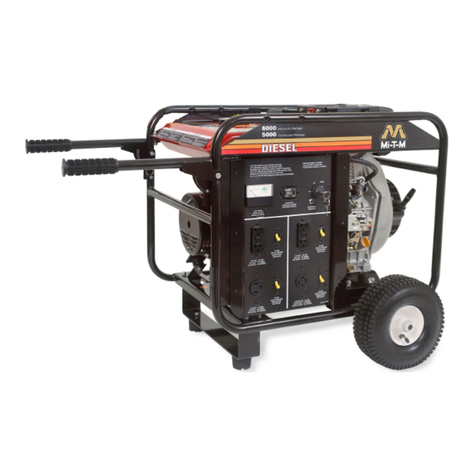
Mi-T-M
Mi-T-M GEN-6000-0MYE Operator's manual
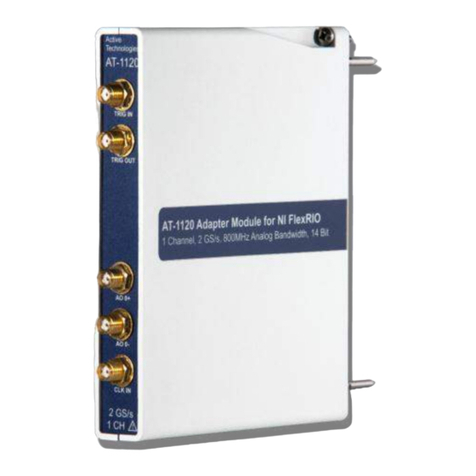
Active Technologies
Active Technologies AT-1120 user manual
